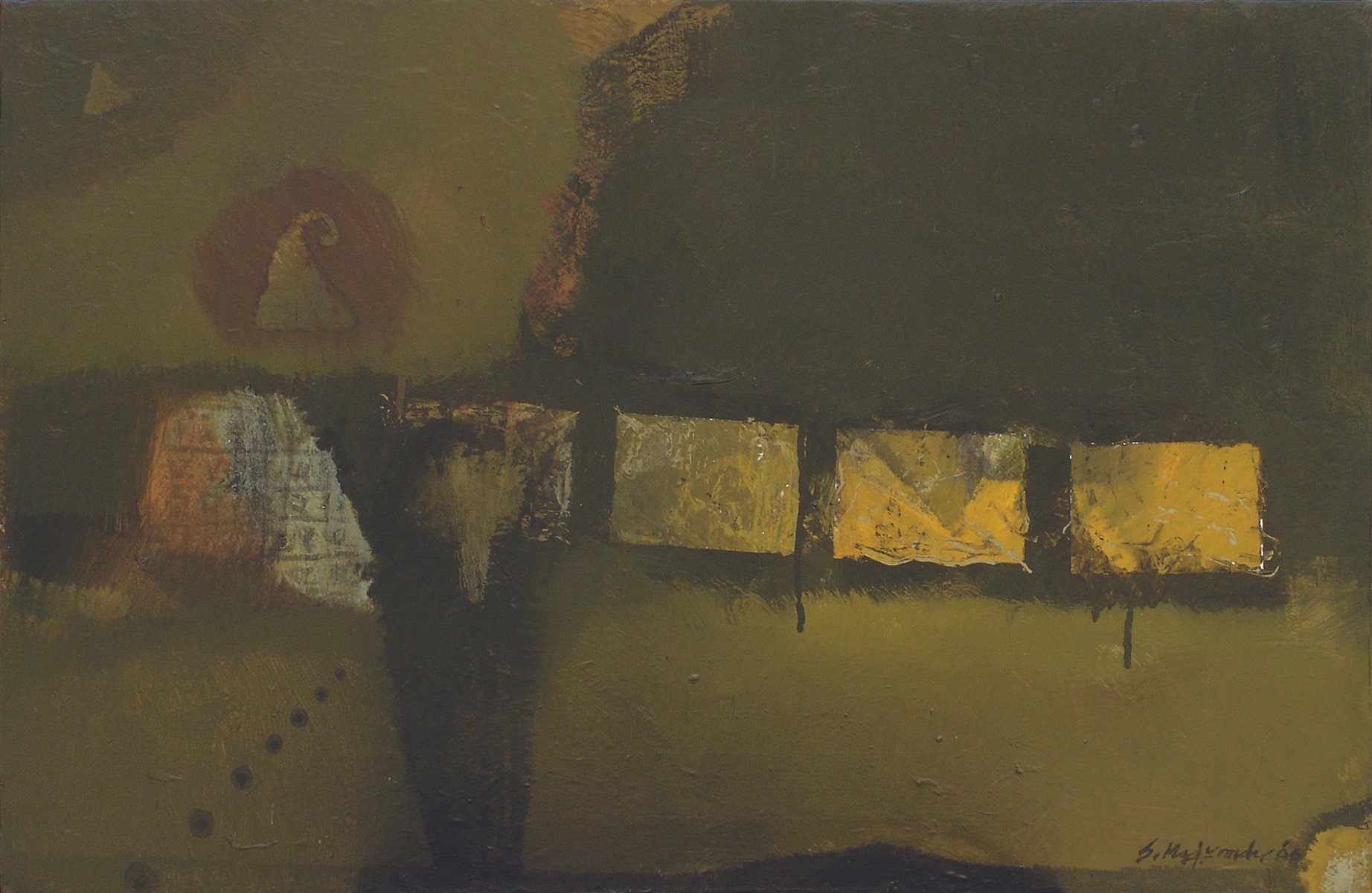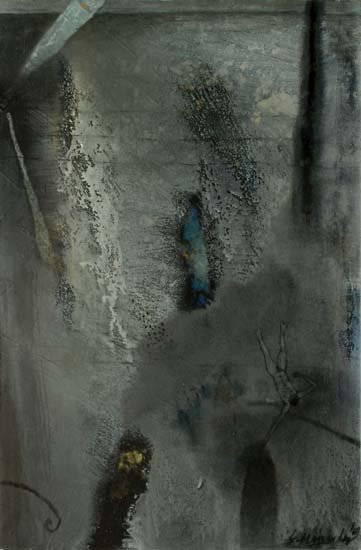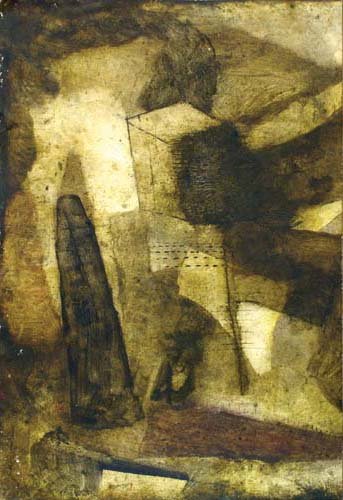
Samindranath Majumdar
April, 2006
Samindranath Majumdar, working mainly in acrylic, overlays layers of paint to create a porous surface often assuming a watery texture with floating forms, at times resisting the flow with stubborn monolithic grandeur; at other times tearing up from within or catching the inevitable stains of immersion.
The marks that a perennial flow leaves on surfaces and the way it breaks forms at their edges to tear away fragments serve for a powerful visual metaphor for Time in its aggressive operation against forms, both natural and man-made. At one level, the forms strive to retain their history, particularly in the endangered/threatened inscriptions that even as they are blurred away assert the original mastery of the creative chiselThe elongated and conical fragments that float through Samindranath's fluid- fibrous surfaces have a life of their own, retaining their animation even in their fractured suspension; at times even suggesting a battle that these shreds and splinters wage on desperately, refusing to go under, with phallic nonchalance.
Samindranath has an ambivalent stance on architecture, especially in its manifestation as monuments of human triumph and pride, the decaying Ozymandiases. He can admire their grandeur only in their fragility in th stream of time, which n Samindranath's vision, lighter than water, with forlorn monuments surfacing n enormous airy landscapes, caught in strange glows of illumination, the light itself lightening the rigid structurality of the monumental formThe layered permeability of Samindranath's surface serves as a space of history that limits and erodes and maybe even liberates the monuments that can only disintegrate and decay and lose their glory over time, but still retain an aura of their own that they draw from that historical space itself, so significantly pervious and austere in Samindranath's recent works.
Samik Bandyopadhyay
Samindranath Majumdar | Riddle with Light | Watercolor on Paper | 13 x 9.5 in | 2002
Samindranath Majumdar | Of night & light & the half - light | Acrylic on Canvas | 36 x 36 in | 2006
Samindranath Majumdar | Now I may wither into truth | Mixed media on layered paper | 19 x 13.5 in | 1999
Samindranath Majumdar | Night & tempest & the sea | Acrylic on Canvas | 30 x 30 in | 2005
Samindranath Majumdar | Let the cage bird & the cage bird mate & the wild bird mate in the wild | Acrylic on Canvas | 30 x 30 in | 2005
Samindranath Majumdar | The Darkness drops again II | Acrylic on Rice paper on Canvas | 24 x 30 in | 2006
Samindranath Majumdar | In other lives | Acrylic & Marble dust on Canvas | 36 x 36 in | 2005
Samindranath Majumdar | Image of poignant recollection | Mixed media on Layered paper | 15 x 22 in | 2001
Samindranath Majumdar | I will arise & go now, & go to innisfree | Tempera on paper | 11.5 x 15.5 in | 2003
Samindranath Majumdar | How pale the substance of memory I | Acrylic on Canvas | 30 x 24 in | 2005
Samindranath Majumdar | How pale the substance of memory II | Acrylic on Canvas | 36 x 36 in | 2005-06
Samindranath Majumdar | High & Solitary & most stern | Acrylic on rice paper pasted on Canvas | 72 x 48 in | 2006
Samindranath Majumdar | For my remembering hour is done II | Watercolor on Paper | 11 x 14.75 in | 2002
Samindranath Majumdar | For my remembering hour is done I | Watercolor on Paper | 11 x 14.75 in | 2002
Samindranath Majumdar | Do I wake or sleep | Acrylic on Canvas | 30 x 20 in | 2004
Samindranath Majumdar | Deep Twilight of rest II | Tempera on Paper | 22.5 x 30 in | 2006
Samindranath Majumdar | Deep Twilight of rest I | Tempera on Paper | 22.5 x 30 in | 2006
Samindranath Majumdar | Bring me my arrows of desire | Tempera on Paper | 22 x 15 in | 1999
Samindranath Majumdar | Beyond the Stir : and tumult of defeated dreams | Tempera on Paper | 10.5 x 14.5 in | 2002
Samindranath Majumdar | All youth's lonely wildness stirred | Acrylic on Canvas | 48 x 72 in | 2006
Sabindranath Majumdar | All these antinomies of day & night | Dry pastel dissolved in Water | 22 x 15 in | 2000
Samindranath Majumdar | All changed, changed utterly: a terrible beauty is born | Acrylic & Marble dust on Canvas | 36 x 36 in | 2005
Samindranath Majumdar | The whole World's sadly talking to itself | Acrylic on Canvas | 30 x 30 in | 2005
Samindranath Majumdar | The Everlasting Taper | Acrylic & Marble dust | 30 x 30 in | 2005
Samindranath Majumdar | Till the Moon has taken Flight | Acrylic & Marble dust on Canvas | 36 x 36 in | 2005
Samindranath Majumdar | Wrecks of a dissolving stream | Mixed media on paper | 10.5 x 14.5 in | 2001
Samindranath Majumdar | Time drops in decay | Acrylic on Canvas | 34 x 42 in | 2004-06
Samindranath Majumdar | The Darkness drops again I | Acrylic on Rice paper on Canvas | 24 x 36 in | 2005 - 06
Samindranath Majumdar | Riddle with light II | Watercolor on Paper | 13 x 9.5 in | 2002
Samindranath Majumdar | Time drops in decay II | Acrylic on gesso ground | 30 x 41 in | 2005





























